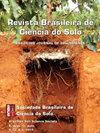Soil fertility, nutritional status, and sugarcane yield under two systems of soil management, levels of remaining straw and chiseling of ratoons
IF 2
4区 农林科学
Q3 SOIL SCIENCE
引用次数: 1
Abstract
Conservation management practices with minimum soil mobilization, maintenance of amounts of straw in the soil, and chiseling of ratoons interrows can be beneficial to soil quality, nutrition and sugarcane yield; however, the combination of these practices and their influence over the culture cycle should be better understood. This study aimed to assess the effects of levels of remaining straw and chiseling in the cultivation of ratoons on soil fertility, nutritional status and yield of stalks and sugar in one sugarcane cycle (five ratoons), under no-tillage and conventional tillage systems. The study was performed in Dourados municipality, Mato Grosso do Sul, Brazil, in areas with a Oxisol (Latossolo) with very clayey texture. Design in randomized blocks was adopted, with four repetitions, in a subdivided portions scheme. Portions were composed of levels of remaining straw (0, 50 and 100 %), annually, and collected alternately in odd years (0I) and even years (0P) established after the plant harvest; sub-portions were composed of systems with and without chiseling. In the fourth ratoon, leaf diagnosis was made with quantification of macro-nutrient contents, and during the fifth ratoon soil samples were collected for chemical analyses. By the end of the cycle, accumulated yields of stalks and sugar were determined. In both management systems, keeping 100 % of straw improved soil fertility and kept higher yield levels in one sugarcane cultivation cycle, while chiseling did not influence soil fertility, nutrition and sugarcane yield. The use of no-tillage farming for sugarcane cultivation proved to be feasible in corrected environments, and did not reduce stalk and sugarcane yield. Straw removal influenced nutrient leaf contents, regardless of soil management.两种土壤管理制度下的土壤肥力、营养状况和甘蔗产量
保持管理措施包括最小限度地调动土壤、保持土壤中秸秆的数量和凿开间秧,可有利于土壤质量、营养和甘蔗产量;然而,应该更好地理解这些实践的结合及其对文化周期的影响。本研究旨在评估免耕和常规耕作制度下,秸秆残留量和刈割量对一个甘蔗周期(5个秸秆)土壤肥力、营养状况、秸秆和糖产量的影响。该研究是在巴西南马托格罗索州杜拉多斯市进行的,在具有非常粘土质地的Oxisol(拉托索罗)地区。采用随机分组设计,重复4次,采用分段设计。部分由剩余秸秆水平(0%、50%和100%)组成,每年一次,在收获后建立的奇数年(0I)和偶数年(0P)交替收集;子部分由有和没有凿凿的系统组成。在第4个生长期,对叶片进行大量养分含量的定量诊断;在第5个生长期,采集土壤样品进行化学分析。在循环结束时,确定了秸秆和糖的累积产量。在两种管理制度下,保持100%秸秆都能提高土壤肥力,并在一个甘蔗栽培周期内保持较高的产量水平,而凿槽对土壤肥力、营养和甘蔗产量没有影响。在校正后的环境下,采用免耕方式种植甘蔗是可行的,并且不会减少秸秆和甘蔗产量。无论土壤管理方式如何,秸秆去除都会影响养分叶片含量。
本文章由计算机程序翻译,如有差异,请以英文原文为准。
求助全文
约1分钟内获得全文
求助全文
来源期刊

Revista Brasileira De Ciencia Do Solo
农林科学-土壤科学
CiteScore
3.00
自引率
11.80%
发文量
32
审稿时长
9-24 weeks
期刊介绍:
The Revista Brasileira de Ciência do Solo is a scientific journal published by the Brazilian Society for Soil Science (SBCS), founded in 1947, and is responsible for the propagation of original and inedited technical-scientific work of interest for Soil Science.
Contributions must not have been previously published or submit to other periodicals, with the only exception of articles presented in summarized form at professional meetings. Literature reviews are accepted when solicited by the Editorial Board.
 求助内容:
求助内容: 应助结果提醒方式:
应助结果提醒方式:


